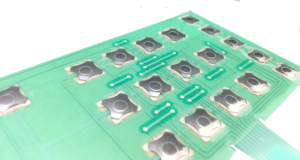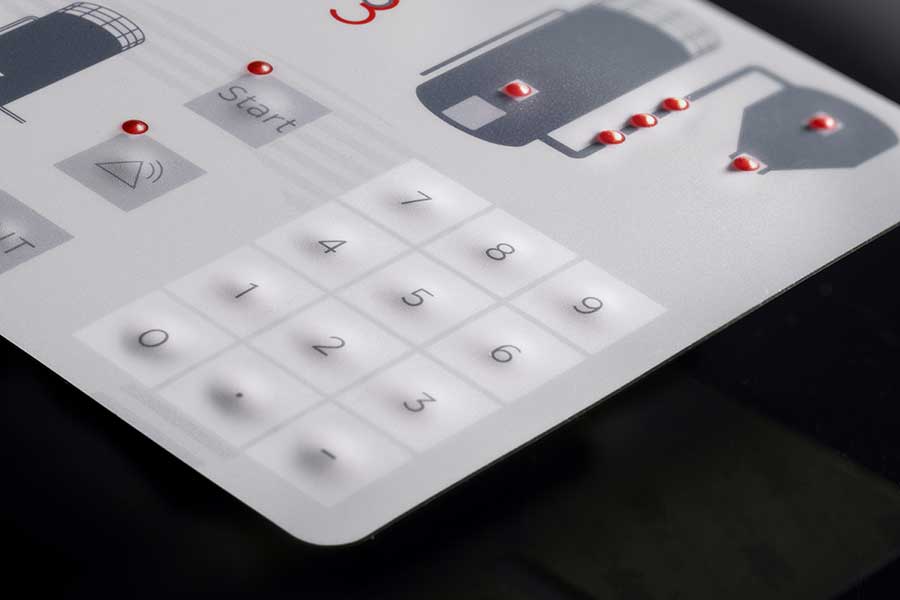Check Out Different Kinds Of Membrane Switch Technologies for Your Requirements
Check Out Different Kinds Of Membrane Switch Technologies for Your Requirements
Blog Article
Understanding the Performance of Membrane Changes for Customer User Interface Tools
The performance of membrane switches over stands for a considerable advancement in individual interface style, combining performance with visual convenience. These switches operate via a multi-layered structure that equates user communications into electric signals, permitting both small formats and durability against ecological factors. As sectors significantly prioritize customer experience, understanding the subtleties of membrane button technology ends up being vital. What effects do these improvements hold for future applications, and how might they redefine individual communications across numerous gadgets?
What Are Membrane Switches?
Membrane layer buttons are innovative interface devices that help with individual communication with digital tools. These versatile components include several layers, consisting of a graphic overlay, spacer, and a printed circuit layer. The style permits for a seamless integration into different electronic tools, boosting both the visual and functional aspects of interface.
Membrane buttons are frequently used in a wide variety of applications, from house appliances to industrial equipment and clinical tools. Their building and construction usually features a thin account, making them an ideal selection for compact styles. The responsive comments offered by these switches can be engineered to fulfill details individual preferences, ensuring effective communication in between the individual and the device.
Resilience is another substantial benefit of membrane buttons, as they are immune to dust, dampness, and chemicals, which boosts their life expectancy sought after settings. Furthermore, these switches can be tailored in terms of shape, dimension, and graphic layout, enabling for branding and user-specific features. On the whole, membrane changes stand for a functional service for boosting individual experience in electronic gadgets, combining capability with aesthetic allure in an efficient fashion.
Exactly How Membrane Layer Changes Job
Operating on a simple principle, membrane layer switches use a split building to sign up individual input effectively. Each switch contains multiple layers, consisting of a printed circuit layer, a spacer layer, and a leading visuals layer, which are created to work with each other seamlessly. When an individual presses the top layer, it compresses the spacer layer, bringing the conductive elements of the circuit layer right into contact with each other.
This call creates a closed circuit, signaling the tool to perform a details feature. The style enables different configurations, consisting of tactile feedback, which can boost the customer experience by offering a physical experience upon activation. The materials used in membrane layer buttons commonly consist of versatile substrates, such as polyester or polycarbonate, which make sure resilience and strength against deterioration.

Trick Advantages of Membrane Buttons

An additional significant benefit is their density. Membrane layer buttons are thin and lightweight, which enables suppliers to save space in their gadgets without compromising performance. This attribute is specifically beneficial in websites applications where weight and volume are vital considerations.
In addition, membrane layer buttons are immune to dust, dampness, and chemicals, enhancing their toughness. This durability expands their life-span and decreases the demand for constant substitutes, leading to cost savings in time.
Additionally, the responsive feedback given by membrane buttons can be maximized to enhance individual interaction. They can consist of attributes such as increased switches or distinct clicks, enhancing use and user experience.
Applications Across Industries
Interface gadgets making use of membrane switches prevail in a wide selection of sectors, showcasing their adaptability and functionality. Membrane Switch. In the medical industry, membrane buttons are essential to tools such as analysis tools and individual monitoring systems, where their sturdiness and convenience of cleansing are vital for keeping health requirements. In the auto market, these switches are used in dashboard controls and infomercial systems, giving a streamlined and modern-day interface for customers.
In addition, the customer electronic devices sector gain from membrane switches in devices and handheld tools, where small layout and user-friendly interfaces enhance individual experience. Industrial applications also utilize membrane switches for control board in equipment and automation systems, emphasizing their toughness and resistance to rough settings.
In the aerospace and protection industries, membrane buttons are utilized in cockpit controls and devices, where dependability and efficiency under extreme conditions are extremely important. In addition, check these guys out the gaming sector that site increasingly includes membrane layer buttons in controllers and gallery devices, adding to an interesting user experience. On the whole, the flexibility of membrane switches enables their prevalent usage throughout numerous sectors, underscoring their relevance in modern-day individual interface design.
Future Patterns in Membrane Switch Over Innovation

Additionally, making use of sophisticated materials, such as polycarbonate and polyester movies, is expected to rise, providing boosted resilience and resistance to environmental stress factors. These materials contribute to the overall durability of membrane buttons, making them appropriate for harsher commercial applications.
Furthermore, the unification of smart modern technology, including IoT connectivity, will allow membrane buttons to communicate with various other devices and systems, assisting in a much more interactive individual experience. This fad aligns with the expanding demand for smart gadgets across various industries, from medical care to consumer electronics.
Last but not least, modification options are anticipated to expand, enabling manufacturers to produce bespoke options customized to details customer requirements and choices. These advancements will certainly position membrane layer buttons as essential parts in the development of interface innovation.
Final Thought
Finally, membrane switches over stand for a critical advancement in interface technology, providing a reliable and versatile service for varied digital applications. Their split building and construction facilitates small design, while features such as responsive responses boost customer communication. The resilience against ecological factors further solidifies their energy throughout several industries. As developments in material scientific research and touch sensing technologies proceed, the capability and applicability of membrane layer buttons are expected to broaden, enhancing their relevance in modern electronic tools.
Report this page